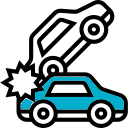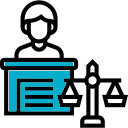
Getting a car insurance inspection after an accident, and everything that follows afterward is part of what can be a confusing process. This is often even more difficult for you if you’ve been injured in the same accident that damaged your car, as you might have lots of other things on your mind as well.
Despite that, your insurance company is still going to need to inspect your car after it’s been involved in an accident. This is an important step in getting your car repaired or replaced, so here’s what you can expect, and what you need to know about the entire process.
What is a Car Insurance Inspection?
A car insurance inspection after an accident is a standard part of the insurance claims process. Insurers must know the damage caused to each vehicle and the estimated repair cost. This is a vital part of the litigation process because, without the evidence derived from a formal car inspection after an accident, it would be impossible to determine the dollar value of the claim.
Car inspections are carried out in two ways. First, a claims adjuster may attend the scene of an accident or visit you at your home to inspect the vehicle and take pictures. Alternatively, you can visit an approved body shop, where a member of staff will conduct a full inspection of your vehicle. This will depend on your insurance provider’s requirements.
While this may sound intimidating, the process is generally painless. In some cases, you may have the choice of visiting a repair shop of your choice or comparing quotes from multiple repair shops.
Check the terms of your auto insurance policy for more information on what to do after your car accident
Numerous Variables
No two car accidents are ever alike. As a result, there are numerous variables that can affect the entire process of getting a car insurance inspection after an accident. Between having your vehicle repaired or replaced, dealing with lost wages as a result of recovering from injuries received during the accident, and everything else that goes along with the wake of a traffic collision, there’s almost never a cut and dry example of what will happen afterward.
That being said, there are a number of things that will need to be resolved after a car accident, and these things are universal enough to provide some useful background that can help you prepare for any eventuality. These elements are common enough to have at least a few occur if you ever end up in an accident yourself.
Whose Fault Is It, Anyway?
One of the most important things to determine, especially in states that do not have “no fault” insurance, is which driver was responsible for the accident occurring. Once fault is decided, it makes a major difference in whose insurance company foots the bill for compensating others for injuries and damage.
It’s often that getting a car insurance inspection after an accident can help determine fault. Based on the damage your vehicle sustained, and where the damage occurred, this information can help back up a claim against an at-fault driver. This is especially true in the context of things like police reports, accident photos, and eyewitness accounts. Comparing the damage done to your vehicle to that done to the other car or cars involved in the accident can also help corroborate your version of events.
What Happens When It’s the Other Driver’s Fault
Determining fault is important because this can affect how much reimbursement you get from the at-fault driver’s insurance. Unfortunately, in some cases, the amount of money you’re entitled to is limited by the extent of that driver’s policy. In other words, if the at-fault driver has maximum cover for just $10,000 in property damage, repairs that cost over and above that amount will not be covered by the at-fault driver’s policy.
This is why it’s important to ensure that your own insurance coverage is sufficient enough to bridge the gap between damage done to your vehicle and the financial responsibility of the at-fault driver’s insurer. There are a number of ways to do this, which include purchasing underinsured or uninsured motorist coverage. Maintaining collision and comprehensive insurance can also help cope with costs over and above the policy limits of an at-fault driver.
Sometimes, You’re the One At Fault

It might not be a pleasant thought, but there’s always a chance that you’ll be the one making a mistake behind the wheel. If an investigation of an accident raises suspicions that you might be at fault, and the results of your car insurance inspection after an accident reinforce those suspicions, you (and your insurance company) may be on the hook to pay for any damages that occurred during the accident.
There are a number of ways that you could be determined to be at fault. They include:
- Causing the car accident directly, through action or inaction
- Causing an accident to not just another vehicle but any other inanimate object
- An accident happening while your vehicle was stationary
- An accident happening to your vehicle while it was unattended
In these instances, there are some options open to you. You can have your insurance company pay for the damages up to and including your policy limits. Be aware that this means you’ll need to pay for the repairs of not just any vehicles you’ve damaged but your own car as well. This is, of course, why many motorists pay for comprehensive or collision coverage as well. Bearing that (and this is not necessarily a recommended option), you can pay some, or even all, of the damages out of pocket directly.
Are You in Need of a Vehicle Insurance Photo Inspection After the Accident?
You may wonder, “Why does my insurance company want to inspect my car?”
While you are not legally required to allow a photo inspection, cooperating is in your best interests. A car damage inspection will involve taking photos of the vehicle and any visible damages. These images will be used to evaluate the cost of repairing the damages, including labor fees. Note that both parties will receive the same inspection.
So, in which circumstances can you expect an insurance adjuster inspection?
Pre-Insurance Photo Inspection
Some states may require you to undergo a photo inspection before issuing a policy. The purpose is to protect the driver and the insurance company.
During this type of photo inspection, the inspector will take photos of the vehicle's physical condition and record the Vehicle Identification Number (VIN), options, accessories, and odometer reading.
The results of this inspection will determine your quote.
Vehicle Inspection After an Accident
You will also receive a photo inspection if you have been involved in an accident. Even though the attending officer may take photos of the damages to attach to their official report, the insurance company may also want to perform a photo inspection to assess the dollar value of the damages.
If an insurer requires this, a claims adjuster will be assigned to your case. It’s their job to investigate the claim, including carrying out a photo inspection.
What is CARCO?
Five states require you to undergo a pre-insurance inspection before you can purchase physical damage coverage. The name is derived from the company CARCO, responsible for filing these reports with insurance companies.
Currently, the only states requiring CARCO inspections are:
- Florida
- Massachusetts
- New Jersey
- New York
- Rhode Island
Every state has its own requirements surrounding these inspections. For example, some states may mandate an inspection within as little as five days of purchasing a vehicle, whereas others give you as many as 35 days. Without a CARCO inspection after the set time window, you will lose the physical coverage within your policy.
So, why is a CARCO insurance inspection necessary? In short, it’s designed to prevent fraud by ascertaining the vehicle's current condition.
Each inspection usually takes up to 15 minutes, and each of the above states will have designated CARCO inspection locations. During the inspection, the inspector will do the following:
- Take photos of the vehicle (Florida is exempted).
- Take an odometer reading.
- Evaluate the overall condition of the vehicle.
- Identify any options or accessories.
Note that you're exempt from CARCO inspections if you have purchased or leased a brand-new car. However, you’ll still need to submit the bill of sale, dealer’s invoices, and window stickers to prove your pre-insurance exemption.
The Benefits of Collision and Comprehensive Coverage
While there are exceptions to this rule, collision coverage is an excellent way to help you pay for at-fault accidents. This means that if you’re responsible to pay for the repairs to other vehicles, or if your vehicle was the only one involved in the accident, collision coverage can help you cope with those costs.
Comprehensive coverage works in a similar manner, though it’s more specific: it can aid in covering car repair costs when your vehicle was parked and unattended when the accident occurred. If a thunderstorm brought down a tree branch on your hood, or if hailstones cracked your windshield, comprehensive coverage is one likely way to help pay for repairing such damage.
Like most insurance coverage, relying on either collision or comprehensive cover might require you to pay a deductible. Both forms of cover are often optional, though if you’re still financing your vehicle it’s often a requirement of the payment agreement to maintain both collision and comprehensive. This is as much to reduce the burden on them as it is to help you in the event of an accident.
The Steps to Making Insurance Claims
It’s time to directly discuss what happens during an accident claim process. Again, this is a generalized outline, as each accident, and each claim, can and will be different. However, these are the most common steps you’ll encounter.
The Insurance Inspection
Inspections are often the very first step of the car insurance claim process. Whether it’s suspected that you were at fault or if the other driver, if there is one, caused the accident, every vehicle involved in a collision needs to be thoroughly inspected by an insurance company representative.
In many cases, a car insurance inspection after an accident is performed by a trained inspector that works directly for the insurance company. In other instances, an insurer will accept a report filed by a mechanic from an auto body or repair shop. Insurers sometimes like to work with specific repair shops, so you may need to check with your insurance company to find out which auto body shop they’re affiliated with in your area.
Estimating the Damage
Once your car has been inspected and documented sufficiently, your insurance company will now go through the process of determining how much it will cost to repair all the damage your vehicle sustained. This process often occurs either during the inspection or right after it, as it also requires a trained inspector or auto repair shop mechanic.
It’s important to point out that a mechanic and an insurance inspector might not see eye-to-eye on the cost of repairing your vehicle. This often results in the two discussing the difference and working together to find an estimation that seems fair to both of them. This doesn’t always happen, though — something that’s covered below.
Paying for Repair Costs
After inspections and estimates have been finalized, it’s time to determine who’s going to foot the bill for the repair work on your vehicle. If you’re at fault, it will be your insurer paying out; if there was another motorist responsible for the accident, it will be their insurance provider writing the check. Wherever the money is coming from, you do have some options as to what you want to do. These options include putting your own money down first and waiting for the insurer to repay you, or waiting for the insurance company to cut a check to the repair shop.
Each approach has distinct benefits and drawbacks. Paying out of pocket first could leave you at a disadvantage if the insurer and the auto repair shop don’t agree on the total repair cost. Having the insurer pay the repair shop directly may not always be an option, as each insurer has differing repair policies. Make sure to check ahead of time with the insurance company before making a final decision.
Total Loss vs. Repair Reimbursements
Reimbursements for damages caused to your vehicle will take the form of either the repair value or total loss.
A total loss is when the estimated cost of repairing the vehicle exceeds its actual cash value. You’re likelier to have a total loss if your vehicle is older, in poor condition, or involved in a severe road traffic accident.
It’s up to a claims adjuster to determine the dollar value of the repairs and the current actual cash value of the vehicle. But what constitutes total loss isn’t always straightforward. The definition of a total loss varies between states.
Some states will use the Total Loss Threshold (TLT), where the damage must only exceed a defined percentage of the car’s actual cash value. Yet almost half of the states use the Total Loss Formula (TLF). The TLF is where the cost of repair plus salvage value must exceed the car’s actual cash value.
For example, Alabama only requires that the repair cost is 75% or more of the actual cash value to constitute a total loss. On the other hand, Nevada’s TLT is just 50%, whereas Texas puts this figure at 100%.
States like Alaska, Louisiana, Utah, and Washington use the TLF to determine a total loss. As you can imagine, all states require a car inspection after an accident to assess the damages.
When Things Don’t Go Smoothly

As mentioned above, sometimes an insurer won’t agree with a damage estimate conducted by an auto repair shop. It often doesn’t matter if it’s your own insurance company or someone else’s — every insurer is going to want to spend as little as possible on repairs, no matter what. This means you might end up in a dispute with the insurer when it comes to how much they’re willing to pay to cover repair costs.
If you find yourself in such a situation, it’s always a good idea to have a lawyer on your side. In addition, you have the following options:
- Mediation – an attempt that uses an unbiased third party to lead a discussion between all parties that satisfies everyone.
- Arbitration – like arbitration, but the third party makes a legally binding decision that you are compelled, as a matter of law, to agree with.
- A court trial – as a final alternative, you (and your attorney) can rely on the decision of a judge when it comes to the amount of money you’re owed. In the case that your claim also encompasses personal injury elements, you may have a jury present as well.
Alternatives to Insurance
Did you know that there are legal alternatives to conventional auto insurance?
Sometimes, these alternatives can save money and make owning a vehicle cheaper. Let’s explore these alternatives.
Private Mechanic
Enlisting a private mechanic is maintaining a mechanic on retainer to act if you are involved in a road traffic accident.
In most cases, this is reserved for wealthy vehicle owners or owners of vintage or classic cars because all the money comes from your pocket. It could require a sizeable payment, making this an unviable option for most people.
Self-Insurance
Self-insurance is the act of setting money aside to cover the costs of an accident. It is often cheaper than paying for expensive auto insurance premiums, but it can lead to financial devastation if you are involved in a severe accident.
You likely already use self-insurance without realizing it. For example, a car insurance deductible is a type of self-insurance.
If you set your deductible at $10,000, you will likely pay lower premiums than someone with a deductible of $2,500.
The purpose of self-insurance is to allow you to pay for the costs you can afford while shielding you from the ones you cannot.
Usage-Based Insurance
Usage-based insurance is designed to offer premiums that reward good driving. An increasing number of auto insurers are offering this option as an alternative to conventional car insurance.
If you’re on one of these policies, a small device will be installed on your vehicle to track your driving. This device measures speeding, acceleration, harsh braking, mileage, and the time of day you drive.
These metrics are used to score your driving performance. Higher scores will lead to lower auto insurance rates.
If you’re a good driver with no record of minor or major car accidents, usage-based insurance can save you hundreds of dollars annually. However, read the fine print. If your score is poor, you may see increased insurance premiums.